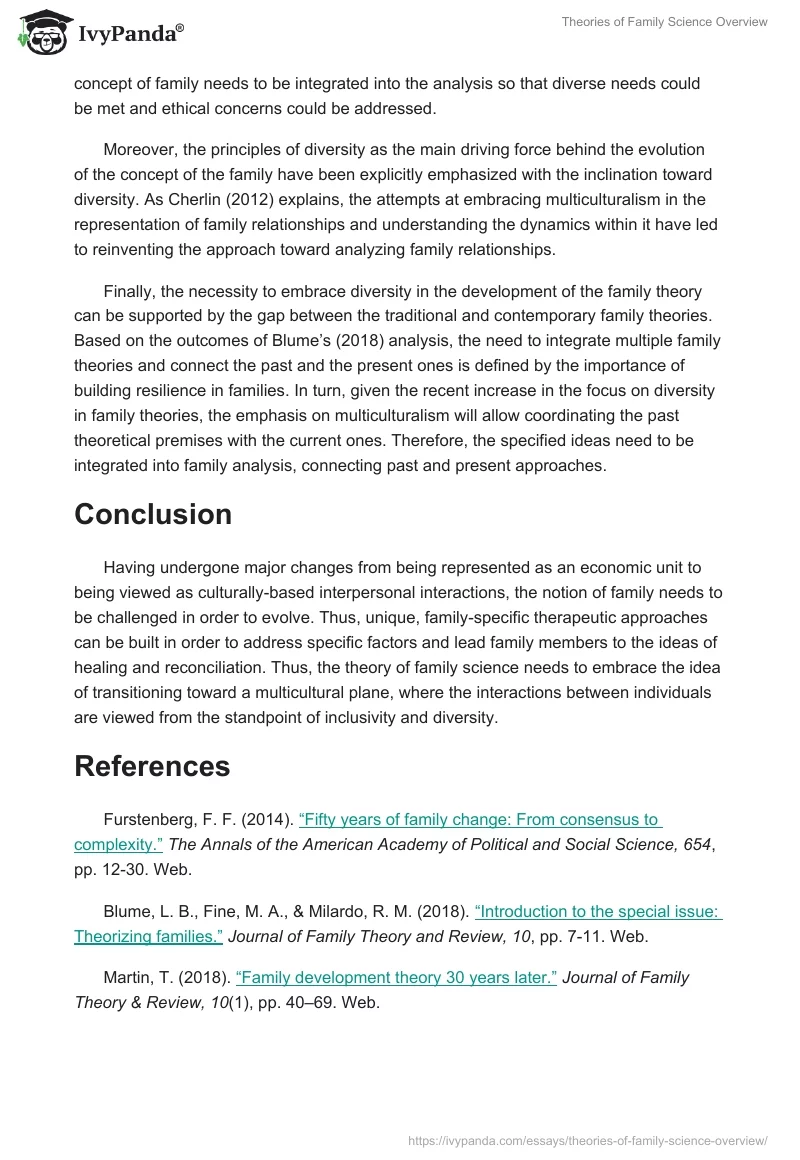Introduction
Understanding family patterns is vital to the management of their members’ needs and the opportunity to make the relationships within it healthier. Specifically, the process of change requires particularly close attention since changing behaviors is the first step toward making the interactions between family members healthier (Furstenberg, 2014). Over the years, family dynamics have been studied as a monolithic concept that reflected its connection to the economy. However, as time passes, a more flexible approach toward defining family relationships geared toward the analysis of interpersonal interactions and the promotion of diversity has been introduced.
Thesis
Evolving from the concept of a unit representing a support system from an economic standpoint into the idea of creating an emotional bond and, thus, building trust-based relationships, the family theory appears to be geared toward normalizing transitions in an effort to encourage diversity and manage ethical concerns.
Supporting Points
The focus on transitions within families as the means of managing the pressure of adverse external factors is crucial to family resilience. Therefore, the study of various family structures, ad interactions including the ones that are more complex than the traditional framework, is vital (Furstenberg, 2014). The analysis of the identified issues will help to bring internal, family-specific issues to the light, thus improving the analysis of its relationships and building prerequisites for healthier relationships.
The observed trend can also be found in the assessment of family transitions observed throughout decades within family units. Specifically, Martin (2018) points to the necessity to culturally contextualize the changes and transitions occurring in families in order to develop a corresponding therapeutic approach that will address family members’ needs. Therefore, the idea of perpetual change and the malleability of the concept of family needs to be integrated into the analysis so that diverse needs could be met and ethical concerns could be addressed.
Moreover, the principles of diversity as the main driving force behind the evolution of the concept of the family have been explicitly emphasized with the inclination toward diversity. As Cherlin (2012) explains, the attempts at embracing multiculturalism in the representation of family relationships and understanding the dynamics within it have led to reinventing the approach toward analyzing family relationships.
Finally, the necessity to embrace diversity in the development of the family theory can be supported by the gap between the traditional and contemporary family theories. Based on the outcomes of Blume’s (2018) analysis, the need to integrate multiple family theories and connect the past and the present ones is defined by the importance of building resilience in families. In turn, given the recent increase in the focus on diversity in family theories, the emphasis on multiculturalism will allow coordinating the past theoretical premises with the current ones. Therefore, the specified ideas need to be integrated into family analysis, connecting past and present approaches.
Conclusion
Having undergone major changes from being represented as an economic unit to being viewed as culturally-based interpersonal interactions, the notion of family needs to be challenged in order to evolve. Thus, unique, family-specific therapeutic approaches can be built in order to address specific factors and lead family members to the ideas of healing and reconciliation. Thus, the theory of family science needs to embrace the idea of transitioning toward a multicultural plane, where the interactions between individuals are viewed from the standpoint of inclusivity and diversity.
References
Furstenberg, F. F. (2014). “Fifty years of family change: From consensus to complexity.”The Annals of the American Academy of Political and Social Science, 654, pp. 12-30. Web.
Blume, L. B., Fine, M. A., & Milardo, R. M. (2018). “Introduction to the special issue: Theorizing families.”Journal of Family Theory and Review, 10, pp. 7-11. Web.
Martin, T. (2018). “Family development theory 30 years later.”Journal of Family Theory & Review, 10(1), pp. 40–69. Web.
Cherlin, A. J. (2012). Goode’s world revolution and family patterns: A reconsideration at fifty years.Population and Development Review, 38, pp. 577-607. Web.


